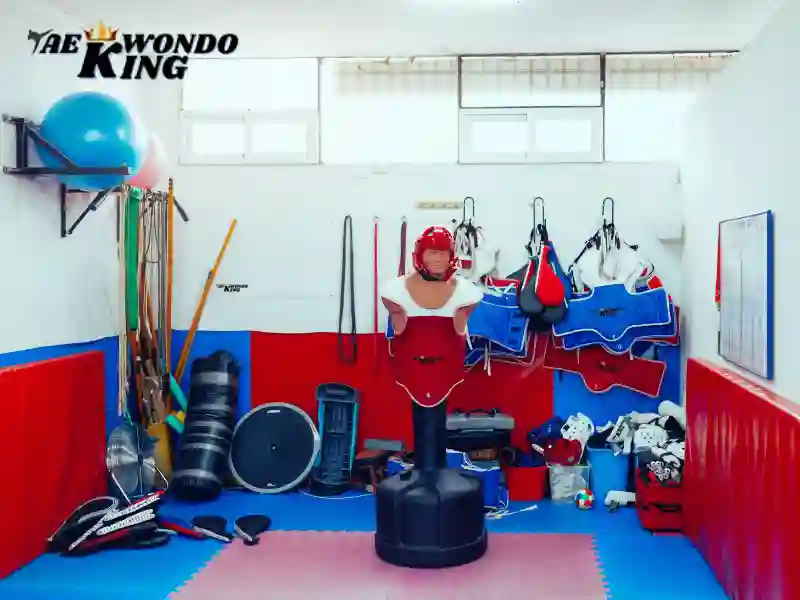
Back when I started training, I thought all I needed was my uniform and a strong kick, but soon I realized how important the equipment used in Taekwondo really is. From chest protectors that absorb powerful strikes to simple hand gear that builds confidence, every piece matters more than it seems. As a Taekwondo coach and competitor, I’ve tested and trusted this gear through real sparring, tournaments, and daily drills. In this guide, we’ll walk you through each essential item, why it matters, and how it supports your training. Stick around, you might discover something that boosts your performance instantly.
The equipment used in Taekwondo serves as more than just tools for training; they are integral components that facilitate safe and effective skill development. From the dobok that embodies the spirit of discipline to the protective gear that ensures safety during sparring, each piece of equipment plays a vital role in a practitioner’s journey to mastery.
See the latest Top-Rated New Balance 480 Price Today Used by Champions Runners.

Name of Taekwondo Equipments
Taekwondo, a dynamic and disciplined martial art that originated in Korea, is renowned for its powerful kicks, precise strikes, and intricate forms. To facilitate effective training and enhance safety, practitioners rely on a range of specialized equipment. Whether you’re a seasoned taekwondo practitioner or a beginner stepping onto the training mat for the first time, understanding the essential equipment used in taekwondo is crucial. This comprehensive guide delves into the ten fundamental pieces of equipment that play a pivotal role in the practice and mastery of taekwondo.
By embracing the dobok, belt, hand gear, shin guards, forearm pads, heavy bags, kicking paddles, kicking shields, chest protector, foot protector, forearm guards, groin guards, gloves, hand wraps, headgear. Mouth guard, focus mitts and pads, kicking targets, mouthpiece groin cup, sparring gear sets, and rebreakable boards, practitioners are equipped with the essentials needed to progress, refine techniques, and engage in dynamic training sessions. The synergy between these pieces of taekwondo training equipment and the dedication of practitioners creates an environment where the art of Taekwondo flourishes, fostering growth, confidence, and skill that transcends the training mat.
Dobok (Taekwondo Uniform)
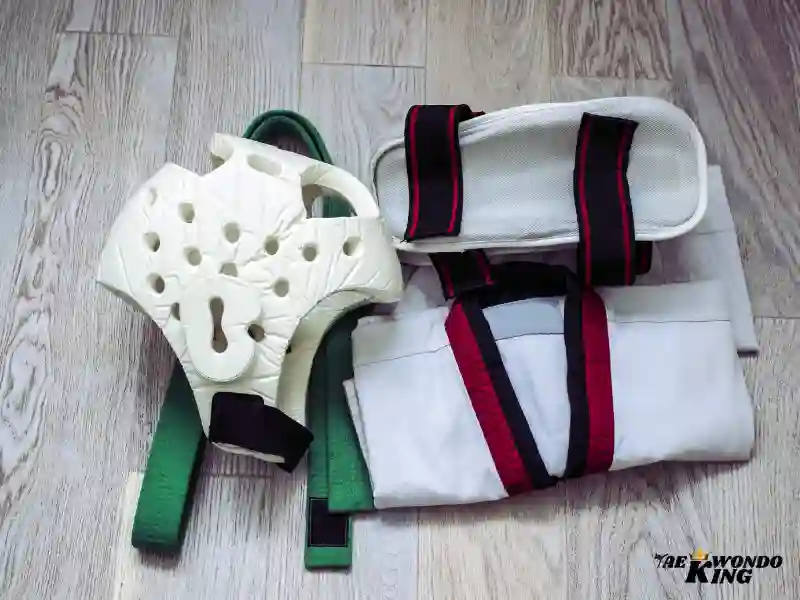
The dobok, or taekwondo uniform, is a symbolic representation of the practitioner’s dedication to the art. It typically consists of a jacket, pants, and a white belt (for beginners) that signifies a blank slate and readiness for learning. As practitioners advance in rank, colored belts are worn to denote their progress. The dobok’s lightweight, breathable fabric ensures comfortable movement during training equipment, while its design maintains the tradition and respect inherent in taekwondo practice.
The dobok, also known as the Taekwondo uniform, is more than just attire; it symbolizes the spirit of discipline and unity that runs through the practice. The dobok consists of a white jacket and pants, often adorned with a colored belt that signifies the practitioner’s rank. The uniform’s design allows for a wide range of motion, making it conducive to executing kicks, strikes, and forms with precision and comfort.
Belt (Dhee or Ti in Korean)
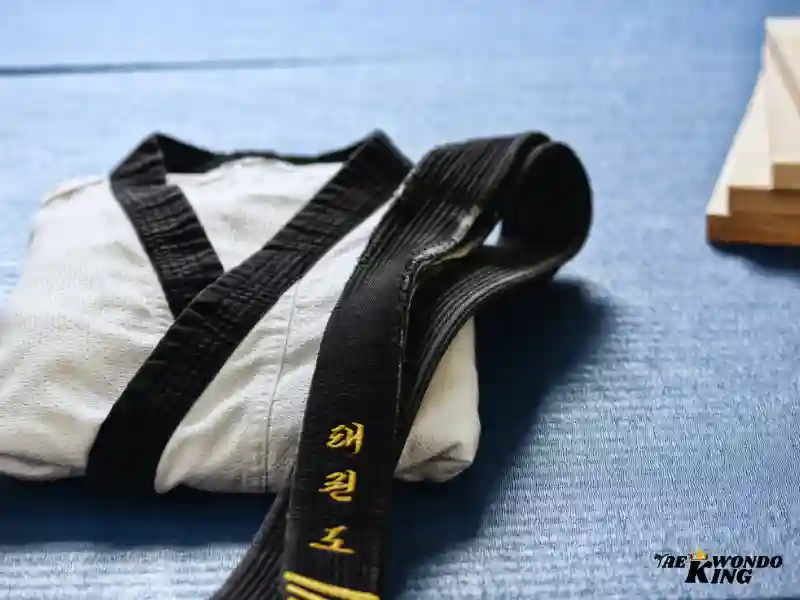
The belt, or Dhee in Korean, serves as a visual representation of the practitioner’s skill level and progression within taekwondo. As students refine their techniques, their belts change color, with each color indicating a specific rank. The belt system fosters a sense of accomplishment, humility, and ongoing commitment to growth. Starting with a white belt and advancing through a spectrum of colors, practitioners eventually aim for the coveted black belt, symbolizing a high level of expertise and dedication to the art.
The belt in Taekwondo holds significant meaning as it represents a practitioner’s rank and progress within the art. From white, for beginners to black for advanced practitioners, the belt signifies the stages of growth, learning, and mastery. Each belt color represents a step closer to perfecting techniques, embodying values, and embracing the spirit of taekwondo.
To wear the belt is the same as to wear the uniform for the sports team. This is a symbol that shows that you belong to the sports team your dedication to the sports team and your love for the sport. This is a symbol that shows you love sports. A sports team has different sports with different belts. With taekwondo, the black belt is the symbol of the master of the sport. This is the symbol that shows that you are a real master of the sport. A taekwondo master is a real master of the sport and a real leader. This symbol is very important because it shows that you are a real master of the sport. This is the symbol of your skills in the sport.
See the latest Korean Taekwondo Equipment Price Today.

Protective Gear (Sparring Gear)
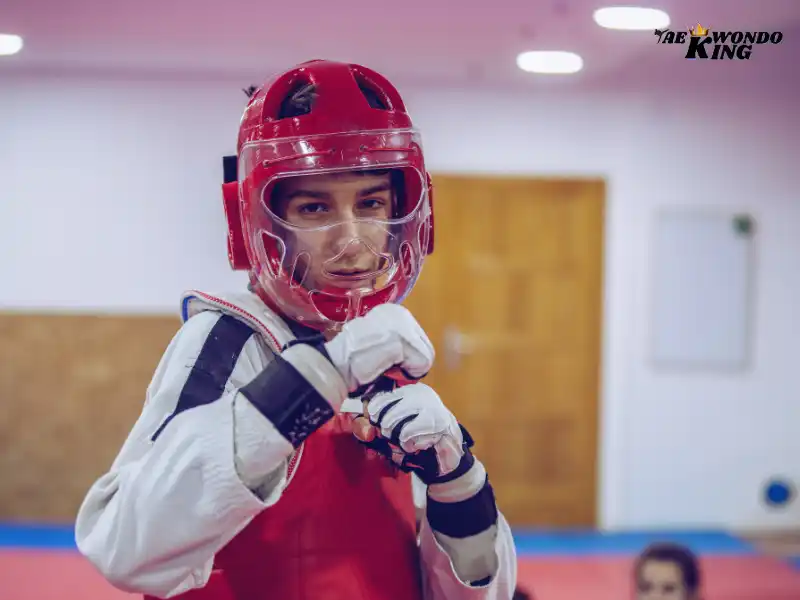
Sparring, a fundamental aspect of taekwondo training, requires the use of protective gear to ensure safety while practicing techniques and controlled combat. The essential sparring gear includes:
Headgear:
Designed to protect the head, face, and ears from impact during sparring sessions. Headgear is essential protective gear worn during sparring sessions. It shields the head and face from potential impacts, minimizing the risk of injuries. It is designed with padding to absorb and distribute impact force, ensuring that practitioners can engage in controlled sparring sessions while prioritizing safety.
Chest Protector (Hog):
The torso, chest protector, foot protector, forearm guards, and groin guard safeguard vital organs from strikes and impacts. It is equipped with sensors that detect scoring techniques during competitions. The chest guard is worn during sparring to safeguard the chest and abdomen from strikes and kicks. It’s constructed with layers of padding to reduce the impact of blows and disperse force. The chest guard enhances confidence during sparring, allowing practitioners to focus on technique without the fear of injury.
Shin Guards:
Protect the shins and lower legs from collisions, especially during kicks and blocks. They offer padding and secure straps to keep them in place.
Forearm Guards:
Shield the forearms and elbows, safeguarding against strikes and blocks. Like shin guards, they provide cushioning and secure fastenings.
Mouth guard:
A custom-fitted mouth guard is essential to protect the teeth and jaw during sparring. It reduces the risk of injury from accidental impacts.
Groin Guard (Male/Female):
Designed for genital protection, the groin guard provides a crucial layer of safety during sparring and contact training. The groin guard is an essential piece of equipment that provides protection to the groin area during sparring sessions. Allowing practitioners to engage in dynamic movements without worrying about potential discomfort or injury.
Focus on Mitts and Kick Pads Equipment Used in Taekwondo

TKD Focus mitts and kick pads are training tools used by instructors to facilitate drills and enhance a practitioner’s striking techniques. These padded targets allow students to practice precise strikes, kicks, and combinations with a partner. Focus mitts are handheld pads that trainers use for punching techniques, while kick pads are larger pads that can absorb powerful kicks. Both tools improve accuracy, speed, power, and timing, contributing to a well-rounded and effective striking game.
If you want to improve your Taekwondo skills, you should try different equipment such as mitts and kick pads. This will help you to gain a better grip on your weapon and it will also increase your strength. You can use these for self-defense and sparring with others. The mitts help you to catch your opponent’s kicks. So, you should focus on getting a grip on these mitts and kick pads to protect yourself.
There are four kicks and four blocks. These kicks and blocks are known as the “Mitts”. To start off, you have to punch with your hands. After that, you can block with your fists and your elbows. Then, you can use your feet and knees. Finally, you can use kicks, punches, and your elbow. It is important to remember these different techniques so that you can be prepared for different situations.
Taekwondo Shoes (Optional)

TKD shoes, while not mandatory, are worn by some practitioners to enhance grip, agility, and stability during training. These lightweight and flexible shoes feature non-marking soles that provide traction on training mats while allowing for quick pivots and movements. Taekwondo shoes are particularly useful in cold or outdoor training environments and can help prevent slipping and injury. Foot pads are a very important aspect of Taekwondo sparring gear sets. Many companies offer the best Taekwondo boot models for martial arts.
Taekwondo is an interesting sport that involves kicking, punching, and jumping. It is a martial art. To compete, you must wear proper footwear. This is the equipment used in Taekwondo. They come in various styles, colors, and designs. However, if you want to play without wearing any shoes, you can buy the Taekwondo shoe. These are also called spats. You will learn more about Taekwondo footwear here. Many companies offer the best models for Taekwondo sparring equipment and martial arts. Taekwondo Shoes are made of leather and are very comfortable. The shoes come in different sizes and colors. These are very useful, and they help to keep your feet cool. They also protect your feet from injuries.
Hand Wraps and Fist Guards Equipment Used in Taekwondo
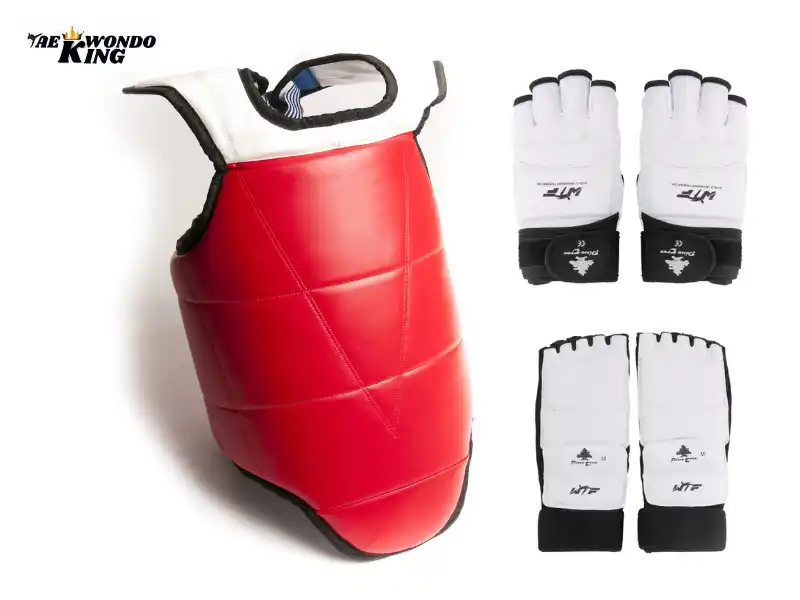
TKD Hand wraps and fist guards are employed to provide additional support and protection for the hands and wrists during training and sparring. Hand wraps are cloth strips that are tightly wound around the hands and wrists before wearing gloves or focus mitts. They stabilize the wrist joint, reducing the risk of strain or injury. There are two types of sparring gloves: WTF and IFT Taekwondo sparring gear models. Fist guards, also known as bag gloves, offer cushioning and padding to minimize impact during striking drills and bag work. Hand Wraps and Fist Guards are the basic equipment used in Taekwondo. The hand wraps are made from cotton and are black. The hand guards are attached to the hand wraps.
If you want to practice Taekwondo, you’ll need to learn the Taekwondo equipment. There are two types of Taekwondo hand wraps, traditional and modern. Traditionally, Taekwondo uses leather hand wraps, but in today’s era, many schools use cotton hand wraps. Modern Taekwondo uses modern equipment. This includes hand guards, shin guards, headgear, and so on. There are also different types of hand wraps and headgear for men and women.
Breaking Equipment
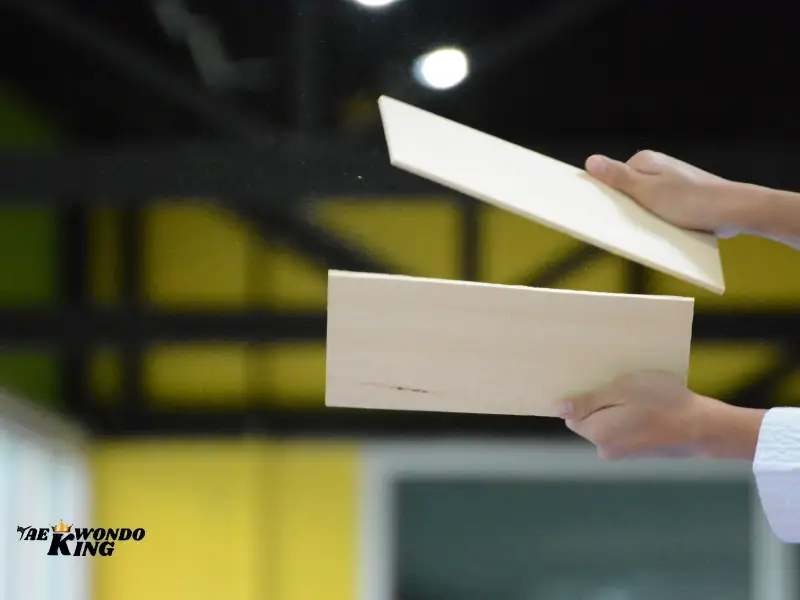
Taekwondo Breaking equipment encompasses a variety of items used for practicing and demonstrating breaking techniques. These techniques require precise focus, power, and technique to break through materials such as wooden boards, bricks, or tiles. Breaking equipment serves as a testament to the practitioner’s mastery of their striking abilities and the principles of taekwondo. Breaking boards and targets are used to practice and demonstrate the power and precision of taekwondo techniques. Wooden boards of varying thicknesses are broken using well-executed kicks and strikes, showcasing the practitioner’s skill and focus. Targets, often made of foam or vinyl, are used for accuracy drills and allow practitioners to fine-tune their striking techniques.
If you are looking for equipment to use in taekwondo, then you might be interested in breaking equipment. There are different types of equipment that you can use to train. They include hand wraps, kettlebells, medicine balls, punching bags, and so on. You should be careful with what kind of equipment you use because some of them are very dangerous. You don’t want to damage your hands, wrists, or arms.
See the latest Top-Rated Rendpas Adjustable Dumbbells Set Price Today Used by Champion.

Gym Bags and Equipment Carriers Equipment Used in Taekwondo
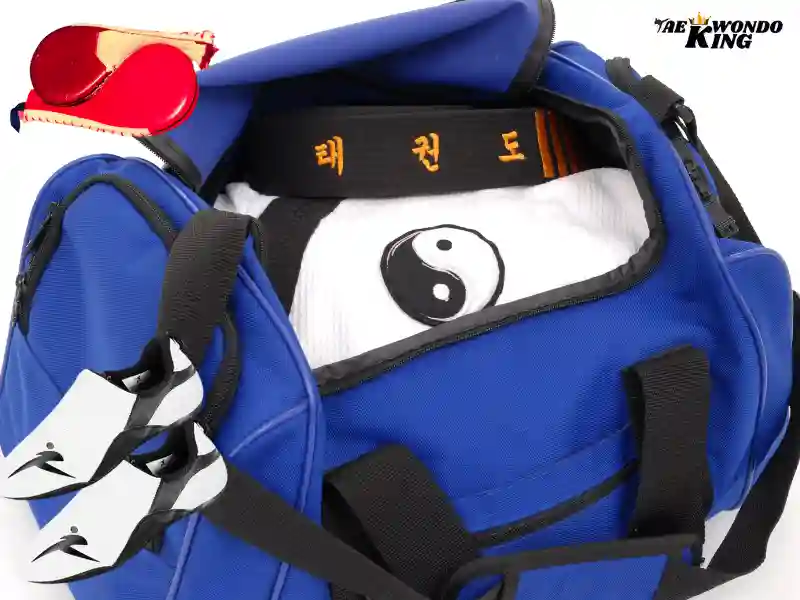
A dependable gym bag or equipment carrier is an indispensable accessory for taekwondo practitioners. It allows you to conveniently transport your uniform, protective gear, shoes, water bottle, and other essentials to and from training sessions. Many gym bags feature compartments and pockets for organized storage, ensuring that you have everything you need for a productive training experience.
In taekwondo, you’ll need to wear gym bags and equipment carriers. Gym bags are an essential item in the gym. It is needed because it keeps your gym bag close to you. You will always be able to find your gym bag if you lose it. It has compartments for everything you need. There is a compartment for your equipment, a compartment for your shoes, a compartment for your gloves, a compartment for your belt, and a compartment for your towel. You can store all of your other items in the gym bag. It is also good to have a gym bag because it makes you less likely to leave anything behind in your car.
The second thing you need is an equipment carrier. The equipment carrier is needed so that you don’t have to worry about your heavy equipment falling out of your car when you park it. You can attach this equipment carrier to your gym bag. If you lose your gym bag, you can still have your equipment carrier attached to your gym bag. You won’t have to worry about your heavy equipment falling out of your car. These are the two essentials that are used in taekwondo.
Mirrors and Training Aids Equipment Used in Taekwondo
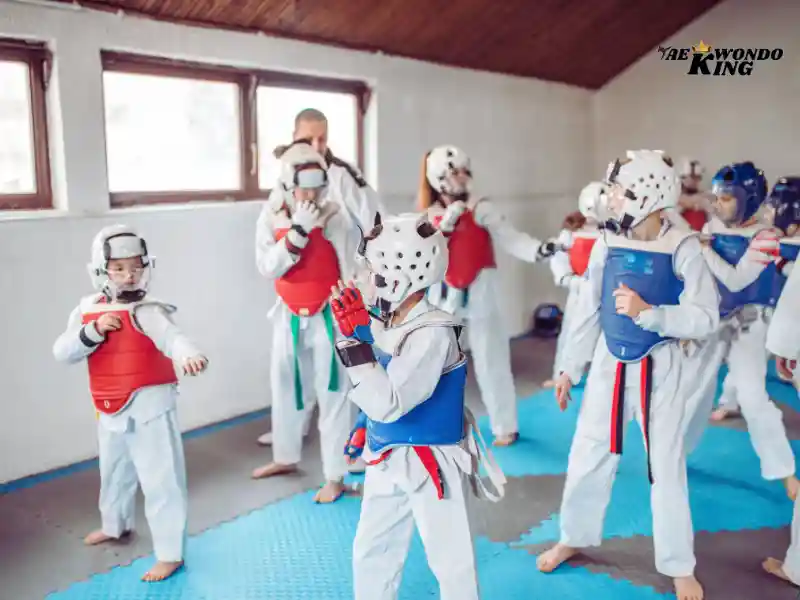
Tkd Mirrors and training aids play a crucial role in refining techniques and perfecting form. Mirrors provide visual feedback, allowing practitioners to observe and correct their movements, posture, and alignment. Training aids, such as balance boards and stretching tools, help improve stability, flexibility, and body control, contributing to enhanced performance in taekwondo techniques.
When you start taekwondo, the first thing you will need is a mirror. This is important because when you’re learning how to kick, it is good to watch yourself while you’re doing it. If you’re going to use a mirror, make sure you have a proper reflection. Your mirror should be able to help you see your mistakes and weaknesses. The second thing that you need is a training aid. These aids are very useful because you can use them to learn better and become better fighters. When you use them, they will improve your skills and help you to achieve your goals.
Which 10 sparring drills are important in Taekwondo?
Many sparring drills are important in Taekwondo, but here are 10 commonly practiced ones:
1. One-Step Sparring: Practicing predetermined attacks and defenses.
2. Free Sparring: Engaging in full-contact sparring within the rules and regulations of Taekwondo.
3. Point Sparring: Focusing on scoring points through controlled strikes.
4. Three-Step Sparring: Similar to one-step sparring but with three predetermined attacks and defenses.
5. Continuous Sparring: Engaging in continuous sparring without breaks or pauses.
6. Reaction Drills: Practicing quick reflexes and response times to various attacks.
7. Target Training: Using focus pads or targets to practice accurate strikes and kicks.
8. Circle Drills: Moving in a circular pattern while sparring, working on footwork and angles.
9. Counterattack Drills: Practicing countering opponents’ attacks with quick counterstrikes.
10. Combination Sparring: Incorporating various combinations of strikes and kicks during sparring sessions.
These drills help improve technique, timing, speed, and overall sparring skills in Taekwondo.
Which 10 stretching exercises can improve my Taekwondo kicks?
Here are 10 stretching exercises that can help improve your Taekwondo kicks:
1. Front Leg Swings: Stand facing a wall and swing one leg forward and backward, keeping it straight.
2. Side Leg Swings: Stand sideways to a wall and swing one leg from side to side, keeping it straight.
3. Standing Quadriceps Stretch: Stand on one leg, grab the other ankle, and pull your heel towards your buttocks.
4. Hamstring Stretch: Sit on the ground with one leg straightened out in front of you and reach forward to touch your toes.
5. Butterfly Stretch: Sit on the ground with the soles of your feet touching and gently press your knees down towards the ground.
6. Side Split Stretch: Sit on the ground, spread your legs as wide as possible, and lean forward to stretch your groin and inner thighs.
7. Standing Calf Stretch: Stand facing a wall, place your hands on the wall, and lean forward while keeping one leg straight and the other leg bent.
8. Hip Flexor Stretch: Kneel on one knee with the other leg bent in front of you, and then lunge forward while keeping your back straight.
9. Seated Spinal Twist: Sit on the ground with one leg bent and the other leg crossed over it, then twist your upper body towards the crossed leg.
10. Neck Stretch: Gently tilt your head to one side, bringing your ear towards your shoulder, and hold for a few seconds. Repeat on the other side.
Remember to warm up before stretching and hold each stretch for about 30 seconds without bouncing. Stretching regularly can help improve your flexibility and enhance your Taekwondo kicks.

Which strategies can help me win in Taekwondo competitions?
Several strategies can help you improve your chances of winning in Taekwondo competitions:
1. Develop strong fundamental skills: Focus on improving your kicks, punches, blocks, and stances. These fundamental skills will form the foundation of your performance in competitions.
2. Improve your speed and agility: Taekwondo requires quick movements and reflexes. Regular training and conditioning exercises can help improve your speed, agility, and reaction time.
3. Study your opponents: Research and analyze your opponents’ strengths and weaknesses. This will help you develop a game plan and strategy that can exploit their weaknesses and capitalize on your strengths.
4. Enhance your flexibility: Flexibility is crucial in Taekwondo, as it allows you to perform high kicks and quick movements. Regular stretching exercises can help improve your flexibility and range of motion.
5. Focus on sparring practice: Participating in sparring sessions with different partners will help you develop your timing, distance control, and defensive skills. It will also help you adapt to different fighting styles and strategies.
6. Work on mental preparation: Taekwondo competitions can be mentally challenging. Practice mental exercises such as visualization, positive self-talk, and managing anxiety to help you stay focused, confident, and composed during matches.
7. Maintain physical fitness: Regular cardiovascular exercises, strength training, and conditioning workouts are important to stay in peak physical condition for competitions.
8. Learn from your experiences: Reflect on your performances in past competitions and identify areas for improvement. Learn from your mistakes and make adjustments in your training and strategy.
Remember, winning in Taekwondo competitions requires a combination of skill, physical fitness, mental preparation, and tactical awareness. Regular training, dedication, and a positive mindset are key to achieving success.
Conclusion
Taekwondo, with its intricate forms, powerful strikes, and rich tradition, demands specialized equipment to facilitate effective training and ensure safety. From the iconic dobok to the protective gear that enables controlled combat, each piece of equipment plays a crucial role in a practitioner’s journey toward mastery.
As you step onto the taekwondo training mat, armed with the knowledge of these essential tools, you embark on a transformative path of physical fitness, mental discipline, and personal growth. The array of equipment used in taekwondo serves as a testament to the art’s dynamic and multifaceted nature, offering practitioners of all ages the means to refine their techniques, elevate their skills, and embrace the spirit of taekwondo’s enduring legacy.
FAQs
1. Taekwondo uniform (Dobok)
2. Rank-indicating belt
3. Protective headgear
4. Chest protector for sparring protection
5. Groin guard for sparring protection
6. Hand wraps for hand and wrist support
7. Shin guards for sparring protection
8. Foot protectors for sparring protection
9. Mouthguard for protection
10. Breaking boards for demonstrations and testing
There are many techniques to practice in Taekwondo, but here are ten fundamental techniques to start with:
1. Front kick (Ap Chagi)
2. Roundhouse kick (Dollyo Chagi)
3. Side kick (Yop Chagi)
4. Back kick (Dwit Chagi)
5. Axe kick (Naeryo Chagi)
6. Hook kick (Huryo Chagi)
7. Crescent kick (Bandal Chagi)
8. Knifehand strike (Sonkal Taerigi)
9. Punch (Jireugi)
10. Elbow strike (Palkup Taerigi)
Remember to practice proper form, balance, and accuracy in each technique. It is essential to train under the guidance of a qualified instructor to ensure correct execution and avoid injuries.
The primary forms practiced in Taekwondo are known as Poomsae or Taegeuk. These consist of a sequence of prearranged movements that imitate different offensive and defensive techniques. There are different levels of Poomsae, each with its own specific set of movements and level of complexity. Furthermore, there are also other forms practiced in Taekwondo, including black belt forms and freestyle forms.
Some common kicks used in Taekwondo include front kick, roundhouse kick, side kick, back kick, and spinning hook kick. These kicks are essential techniques in Taekwondo and are practiced and perfected by practitioners of the martial arts.
See the latest Top-Rated New Balance 480 Price Today Used by Champions Runners.


Founder, Owner, and CEO of TaekwondoKing.
He is one of the top 100 martial artists in the World and among the top 20 referees in Bangladesh.
Ehatasamul Alom is an esteemed Kukkiwon Certified Taekwondo 3rd Dan Black Belt with over 15 years of experience in this dynamic martial art. Born in Rajshahi, Bangladesh, Ehatasamul’s journey with Taekwondo began at the tender age of seven. His passion led him to compete at national and international levels, where he has bagged numerous awards and honors. He is also a member of the Taekwondo National Referee Panel.
With a Bachelor’s degree in Sports Science from the prestigious Rajshahi University, Ehatasamul has a deep understanding of the technical and scientific aspects of martial arts and some other martial arts.
In 2022, Ehatasamul created the “TaekwondoKing.com” to share his knowledge, Free Resources, Values, and Real experiences. His articles focus on Taekwondo training techniques, competition strategies, Sport Products Reviews, and the art’s rich history and philosophy. He also writes about the importance of mental fortitude and discipline, key aspects of his teaching philosophy. He has already launched many sports, Taekwondo, and health-related Free online tools. His goal is to inspire both beginners and seasoned practitioners worldwide through insightful and engaging content.
If you need any help, contact Ehatasamul Alom at any time.


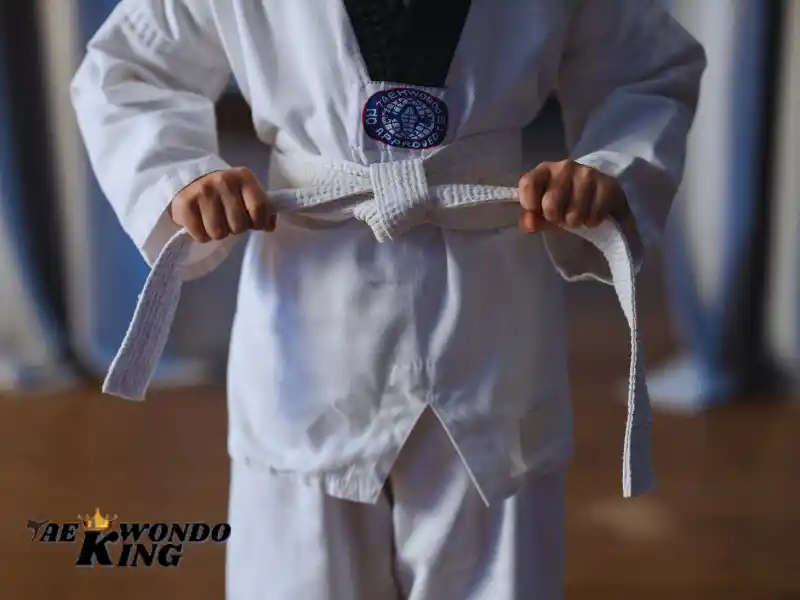


I’m so glad I found this blog. The Taekwondo tips are priceless!